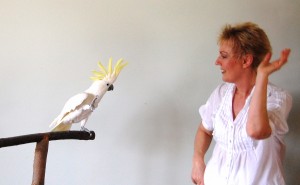
Snowball® was relinquished to us in August of 2007 because he required more attention than his owner, Dane, could provide. Dane brought a CD of Snowball’s® favorite music later that evening and watched our reaction as we played Snowball’s® favorite song “Everybody (Backstreet’s Back)” by the Backstreet Boys. Snowball® danced on my arm for the entire song, stomping his feet, head-banging, and proudly displaying his crest in rhythm to the music. I couldn’t believe my eyes.
We decided to videotape him dancing to his favorite song and placed it on our blog. The video reached countless people through e-mails as it was passed around and soon made it to all corners of the earth. I’d been contacted by a multitude of television shows, news programs, newspapers, magazines, and ad companies all wanted to learn more. I was even contacted by scientists around the world. Among those who contacted me were Dr. Aniruddh Patel and Dr. John Iversen of the Neurosciences Institute in San Diego, CA. We have been collaborating on music cognition studies since October of 2007.
Cockatoos are a very social parrot and they thrive on attention. So it came as no surprise that Snowball’s® dancing evolved from the fact that he could get plenty of attention when engaging in this activity. As his audience encouraged him with laughter, praise, and applause, he would become more and more animated.
The more flamboyant and exaggerated his dance moves became, the more attention he would muster in the form of laughter, praise, and applause. Snowball® had us trained…he danced in order to receive attention.
The “Two Tempo” Experiments
The objective of this series of experiments was to study whether the social aspect of dancing with a partner would take precedence over dancing to the rhythm that was audible to Snowball® or vice versa. I would wear headphones and would dance to the same song as Snowball®; however, during half the trials, the rhythm of the song being played through my headphones would be increased or decreased by 15%.
During the “Two Tempo” series of experimental trials, Snowball® seemed to become impatient and annoyed at my inability to dance to the rhythm of the music. He would attempt to dance with me, but then stop when my rhythm was not in time to the music. Snowball® would turn his back to me and dance to the rhythm of the song playing through the computer speakers. Occasionally he would glance back at me, but this seemed to throw him off rhythm. He would pause, analyze the rhythm, and resume dancing.
This study produced unexpected results. Although Snowball’s® dancing involves a social aspect, he often abandoned the social aspect of dance in order to dance to the rhythm he heard by ignoring his dance partner (me). He would prefer to dance with me absent any music than to dance with me if I were not dancing on the beat of the song playing. This shows us that Snowball® has the ability to analyze the beat.
While this research increases our knowledge and understanding of music cognition in parrots, new questions arise. Does the fact that Snowball® turned his back to me in order to concentrate on dancing to the beat of the music suggest cognitive dissonance in a non-human animal? Perhaps one day that question will be answered as well.
Donate monthly to support the Snowball Studies.
